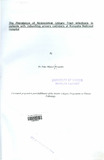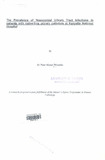| dc.contributor.author | Mwamba, Peter Maturi | |
| dc.date.accessioned | 2013-05-23T14:18:03Z | |
| dc.date.available | 2013-05-23T14:18:03Z | |
| dc.date.issued | 2005 | |
| dc.identifier.citation | Masters in Human Pathology, University of Nairobi, 2005 | en |
| dc.identifier.uri | http://hdl.handle.net/11295/25007 | |
| dc.description.abstract | ABSTRACT
Urinary tract infection IS one of the most common forms of nosocomial infection in
patients and urinary catheterization is the most frequent predisposing factor. These
infections cause considerable morbidity and mortality and confer a great financial burden
on the medical care system. This study was performed to determine the incidence of
catheter-associated bacteriuria, to isolate the etiologic organisms, and to assess their
sensitivity most frequently prescribed antibiotics.
Methods
Two urinary specimens were taken from the catheters of 80 patients admitted at Kenyatta
National hospital general wards and special units who carried an indwelling urinary
catheter for a duration of > 12 hours. The first specimen was taken at the time of
catheterization and the second was taken after 72 hours.
Results
Of 80 patients, 16 (:20%) had a positive culture from which six' different strains were
isolated. 37.5% of the strains belonged to Escherichia coli. All of these strains were
sensitive to Meropenarn and Tazopiperacillin. The sensitivity to commonly used
antibiotics like Gentamicin and Ciprofloxacin was poor at cJ.3.8% and 37.5% respectively.
Most of the organisms isolated were moderately sensitive to Augmentin (62.5%).
Cefuroxirne (68.8%), Nalidixic acid (56.3%). Amikacin (56.3%). Nitrofurantoin (50%).
and Ceftazidirne (68.8%)
Conclusion
from this study it is appropriate to conclude that the prevalence rate at KNH is high at
20% and that the commonest Catheter associated urinary tract infections (CAUTI)
nosocomial microorganisms are enteric bacteria including E coli and Klebsiella
pneumontae. Most organisms isolated show considerable resistance to the commonly
used antibiotics including Gentamicin. Ciprofloxacin and Ceftriaxone and that
Tazopiperacillin and Meropenern seem to be the most effective antibiotics for
Nosocomial CAUTI | en |
| dc.language.iso | en | en |
| dc.publisher | University of Nairobi | en |
| dc.title | The Prevalence of Nosocomial Urinary Tract Infections in patients with indwelling urinary catheters at Kenyatta National Hospital | en |
| dc.type | Thesis | en |
| local.publisher | School of Medicine | en |


